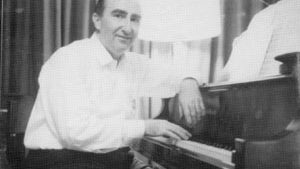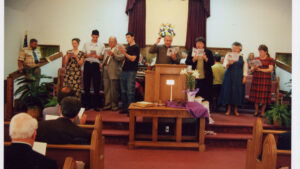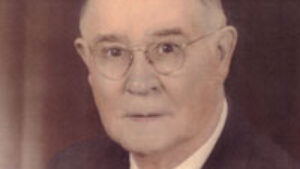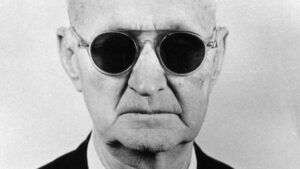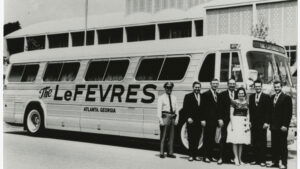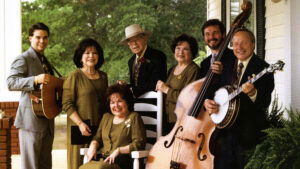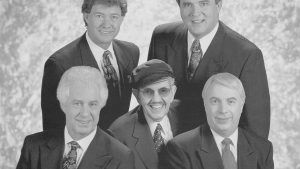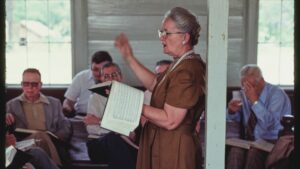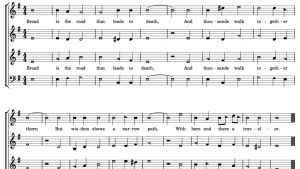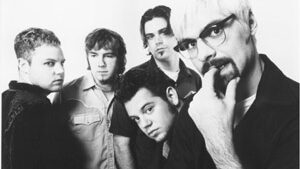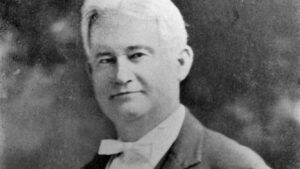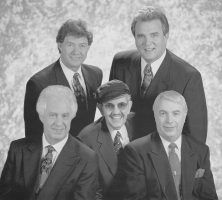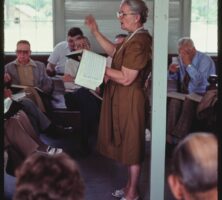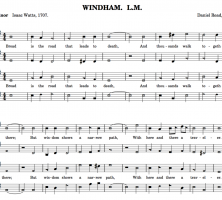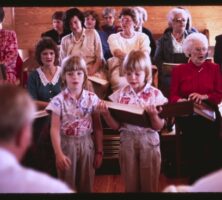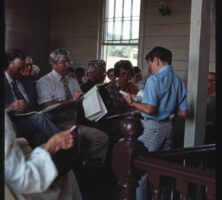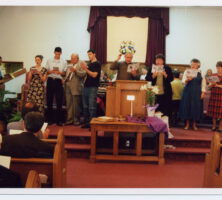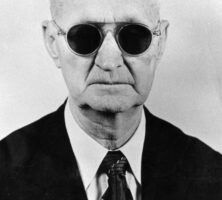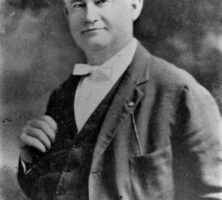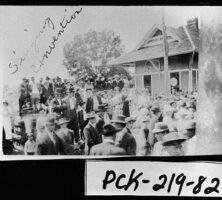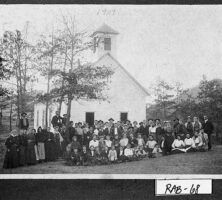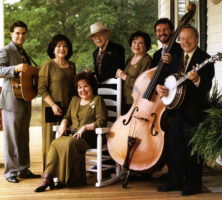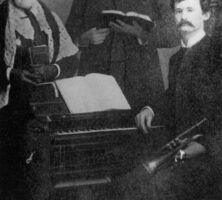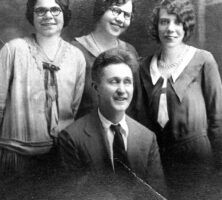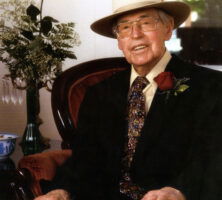The New Georgia Encyclopedia is supported by funding from A More Perfect Union, a special initiative of the National Endowment for the Humanities.
The Statesmen were a renowned gospel group formed in 1948 by Hovie Lister. Over the years the lineup of the group changed many times. Pictured is the last configuration of the performers. Seated left to right, Jack Toney (lead), Hovie Lister (pianist), and Wallace Nelms (tenor); standing left to right, Doug Young (bass) and Rick Fair (baritone).
The New Georgia Encyclopedia does not hold the copyright for this media resource and can neither grant nor deny permission to republish or reproduce the image online or in print. All requests for permission to publish or reproduce the resource must be submitted to the rights holder.
Traditional gospel singer and songwriter Dottie Peoples is also a record producer and the host of the radio show The Dottie Peoples Showcase.
Photograph from Dottie Peoples
The New Georgia Encyclopedia does not hold the copyright for this media resource and can neither grant nor deny permission to republish or reproduce the image online or in print. All requests for permission to publish or reproduce the resource must be submitted to the rights holder.
Babbie Mason is an award-winning contemporary Christian singer and songwriter.
Courtesy of Babbie Mason
The New Georgia Encyclopedia does not hold the copyright for this media resource and can neither grant nor deny permission to republish or reproduce the image online or in print. All requests for permission to publish or reproduce the resource must be submitted to the rights holder.
Southern gospel music songwriter and performer Lee Roy Abernathy was an innovator. He invented a music typesetting system, pioneered the use of public address systems in gospel concerts, and wrote the first singing commercials.
Courtesy of Hargrett Rare Book and Manuscript Library, University of Georgia Libraries, Georgia Music Hall of Fame Collection.
The New Georgia Encyclopedia does not hold the copyright for this media resource and can neither grant nor deny permission to republish or reproduce the image online or in print. Requests for permission to publish or reproduce the resource should be submitted to the Hargrett Manuscript and Rare Book Library at the University of Georgia.
First published in 1844, The Sacred Harp songbook has helped to promote the style of singing known as "Sacred Harp," "shape-note," or "fasola" singing.
Courtesy of Library of Congress, Prints and Photographs Division
The New Georgia Encyclopedia does not hold the copyright for this media resource and can neither grant nor deny permission to republish or reproduce the image online or in print. All requests for permission to publish or reproduce the resource must be submitted to the rights holder.
The shape-note system in The Sacred Harp uses a different shape to represent each of the four syllables in the musical scale: a triangle (fa), a circle (sol), a rectangle (la), and a diamond (mi).
The tune "Windham" as it appears in The Sacred Harp, 1911 edition. Image from Wikimedia.
The New Georgia Encyclopedia does not hold the copyright for this media resource and can neither grant nor deny permission to republish or reproduce the image online or in print. All requests for permission to publish or reproduce the resource must be submitted to the rights holder.
Gapped scales (having less than the usual seven notes) and unusual harmonies help account for this traditional music's characteristic sound. Also unique is the doubling of two parts, both men and women singing tenor and treble. Untrained voices prevail, so the singing sounds loud and exhilarating.
Courtesy of Georgia Council for the Arts, Georgia Traditional Arts Research Collection, Abraham Baldwin Agricultural College Libraries.
The New Georgia Encyclopedia does not hold the copyright for this media resource and can neither grant nor deny permission to republish or reproduce the image online or in print. Requests for permission to publish or reproduce the resource should be submitted to the Georgia Council for the Arts.
The sound of Sacred Harp may vary a bit from region to region, and white singers have different styles from African American singers. But regardless of location or race, Sacred Harp sounds unlike academic choral singing or gospel singing, in which melody dominates and harmony embellishes and supports it.
Courtesy of Library of Congress, Prints and Photographs Division
The New Georgia Encyclopedia does not hold the copyright for this media resource and can neither grant nor deny permission to republish or reproduce the image online or in print. All requests for permission to publish or reproduce the resource must be submitted to the rights holder.
Georgia Tom Dorsey began his career as a blues pianist at the age of twelve in Atlanta. In 1916 Dorsey moved to Chicago, where he assumed the leadership of Gertrude "Ma" Rainey's Wild Cats Jazz Band in 1924 and began recording with "Tampa Red" Whittaker in 1928.
From The Story of the Blues, by P. Oliver
The New Georgia Encyclopedia does not hold the copyright for this media resource and can neither grant nor deny permission to republish or reproduce the image online or in print. All requests for permission to publish or reproduce the resource must be submitted to the rights holder.
Georgia Tom Dorsey became an icon in gospel music during the 1930s and 1940s, working in Chicago with such gospel singers as Mahalia Jackson, Della Reece, and Clara Ward. Dorsey began his career as a blues musician but turned exclusively to spiritual music following the death of his wife in 1932.
Courtesy of Hargrett Rare Book and Manuscript Library, University of Georgia Libraries, Georgia Music Hall of Fame Collection.
The New Georgia Encyclopedia does not hold the copyright for this media resource and can neither grant nor deny permission to republish or reproduce the image online or in print. Requests for permission to publish or reproduce the resource should be submitted to the Hargrett Manuscript and Rare Book Library at the University of Georgia.
The Dewey Caldwell Memorial Singing, a singing convention held at Abilene Baptist Church in Carrollton on March 24, 2002.
Courtesy of Wayne W. Daniel
The New Georgia Encyclopedia does not hold the copyright for this media resource and can neither grant nor deny permission to republish or reproduce the image online or in print. All requests for permission to publish or reproduce the resource must be submitted to the rights holder.
The Reverend Andrew Jenkins of Atlanta (pictured here in 1954) was a leading composer of songs popular among southern gospel singers. He has been credited with more than 800 compositions, of which more than two-thirds are sacred songs.
Courtesy of Mary Lee Eskew Bowen
The New Georgia Encyclopedia does not hold the copyright for this media resource and can neither grant nor deny permission to republish or reproduce the image online or in print. All requests for permission to publish or reproduce the resource must be submitted to the rights holder.
Charlie D. Tillman (photo taken ca. 1930), who called Atlanta home for most of his career, was a pioneer composer, performer, and publisher of southern gospel music. During the almost sixty years that he was involved in the music business, he wrote some one hundred songs and published twenty-two songbooks.
Courtesy of Charles L. Douglas
The New Georgia Encyclopedia does not hold the copyright for this media resource and can neither grant nor deny permission to republish or reproduce the image online or in print. All requests for permission to publish or reproduce the resource must be submitted to the rights holder.
Members of a gospel singing convention gather by the train depot in Jasper, circa 1910. Two conventions were held in the town each year, in May and September, and attracted large crowds from neighboring communities.
Courtesy of Georgia Archives, Vanishing Georgia, #
pck219-82.
The New Georgia Encyclopedia does not hold the copyright for this media resource and can neither grant nor deny permission to republish or reproduce the image online or in print. Requests for permission to publish or reproduce the resource should be submitted to the Georgia Archives.
Members of a singing school at Wolf Fork Baptist Church in Rabun County gather in front of the church for a photograph (1909). This structure was also used as a school at one time.
Courtesy of Georgia Archives, Vanishing Georgia, #
rab068.
The New Georgia Encyclopedia does not hold the copyright for this media resource and can neither grant nor deny permission to republish or reproduce the image online or in print. Requests for permission to publish or reproduce the resource should be submitted to the Georgia Archives.
The popular contemporary Christian music group Third Day has received several Grammy Award nominations, finally winning in 2003 in the best rock gospel album category for Come Together.
Courtesy of Hargrett Rare Book and Manuscript Library, University of Georgia Libraries, Georgia Music Hall of Fame Collection.
The New Georgia Encyclopedia does not hold the copyright for this media resource and can neither grant nor deny permission to republish or reproduce the image online or in print. Requests for permission to publish or reproduce the resource should be submitted to the Hargrett Manuscript and Rare Book Library at the University of Georgia.
Amy Grant has won several Grammy Awards and performed a song from her album, Heart in Motion (1991), at the Grammy ceremonies in 1992. Grant was inducted into the Gospel Music Hall of Fame in 2003.
Photograph by Dave Eagles
The New Georgia Encyclopedia does not hold the copyright for this media resource and can neither grant nor deny permission to republish or reproduce the image online or in print. All requests for permission to publish or reproduce the resource must be submitted to the rights holder.
Amy Grant is one of contemporary Christian music's most prominent singer-songwriters. She has released more than a dozen albums, won numerous Dove Awards, and had successful crossover albums into the pop music world.
The New Georgia Encyclopedia does not hold the copyright for this media resource and can neither grant nor deny permission to republish or reproduce the image online or in print. Requests for permission to publish or reproduce the resource should be submitted to the Hargrett Manuscript and Rare Book Library at the University of Georgia.
Known around the world as the "First Family of Bluegrass Gospel Music," the Lewis Family of Lincolnton have been entertaining at festivals and other gospel and bluegrass music venues since 1951. Their southern gospel harmony is sung to the accompaniment of banjo, guitar, autoharp, and upright bass.
The New Georgia Encyclopedia does not hold the copyright for this media resource and can neither grant nor deny permission to republish or reproduce the image online or in print. All requests for permission to publish or reproduce the resource must be submitted to the rights holder.
Charlie D. Tillman (seated) exhibited early in life a better-than-average talent and inclination for music. His parents were evangelists, and he grew up traveling with them and taking an active role in the musical portion of their services.
Courtesy of Charles L. Douglas
The New Georgia Encyclopedia does not hold the copyright for this media resource and can neither grant nor deny permission to republish or reproduce the image online or in print. All requests for permission to publish or reproduce the resource must be submitted to the rights holder.
The LeFevres, one of the best-known acts performing southern gospel from the 1920s to the 1950s, were based in Atlanta. In 1959 the family bought its first customized tour bus, which was equipped to sleep six people and outfitted with other conveniences to ease the burden of almost around-the-clock travel.
The New Georgia Encyclopedia does not hold the copyright for this media resource and can neither grant nor deny permission to republish or reproduce the image online or in print. Requests for permission to publish or reproduce the resource should be submitted to the Hargrett Manuscript and Rare Book Library at the University of Georgia.
The original LeFevre Trio consisted of brothers Alphus (top right) and Urias (middle right) and Urias's wife, Eva Mae.
The New Georgia Encyclopedia does not hold the copyright for this media resource and can neither grant nor deny permission to republish or reproduce the image online or in print. Requests for permission to publish or reproduce the resource should be submitted to the Hargrett Manuscript and Rare Book Library at the University of Georgia.
The New Georgia Encyclopedia does not hold the copyright for this media resource and can neither grant nor deny permission to republish or reproduce the image online or in print. All requests for permission to publish or reproduce the resource must be submitted to the rights holder.
J. M. Henson was a major contributor to the development of southern gospel music. In 1921 he and a group of other musicians and businessmen formed the Southern Music Plate Company of Atlanta. They published music theory books and songbooks featuring the seven-shape notational system, a staple of vintage southern gospel music.
Courtesy of Hargrett Rare Book and Manuscript Library, University of Georgia Libraries, Georgia Music Hall of Fame Collection.
The New Georgia Encyclopedia does not hold the copyright for this media resource and can neither grant nor deny permission to republish or reproduce the image online or in print. Requests for permission to publish or reproduce the resource should be submitted to the Hargrett Manuscript and Rare Book Library at the University of Georgia.
The New Georgia Encyclopedia does not hold the copyright for this media resource and can neither grant nor deny permission to republish or reproduce the image online or in print. All requests for permission to publish or reproduce the resource must be submitted to the rights holder.
The Jenkins Family (clockwise from left: Jane Walden Eskew Jenkins, Irene Eskew Spain, Mary Lee Eskew, and Andrew Jenkins) presented their first program over the air on Atlanta's radio station WSB in 1922. They were among the first gospel music groups to be heard on any radio station.
Courtesy of Mary Lee Eskew Bowen
The New Georgia Encyclopedia does not hold the copyright for this media resource and can neither grant nor deny permission to republish or reproduce the image online or in print. All requests for permission to publish or reproduce the resource must be submitted to the rights holder.
In 2000 the patriarch of the Lewis Family, Roy "Pop" Lewis, was inducted into the Southern Gospel Music Hall of Fame, located at Dollywood in Pigeon Forge, Tennessee.
The New Georgia Encyclopedia does not hold the copyright for this media resource and can neither grant nor deny permission to republish or reproduce the image online or in print. All requests for permission to publish or reproduce the resource must be submitted to the rights holder.
